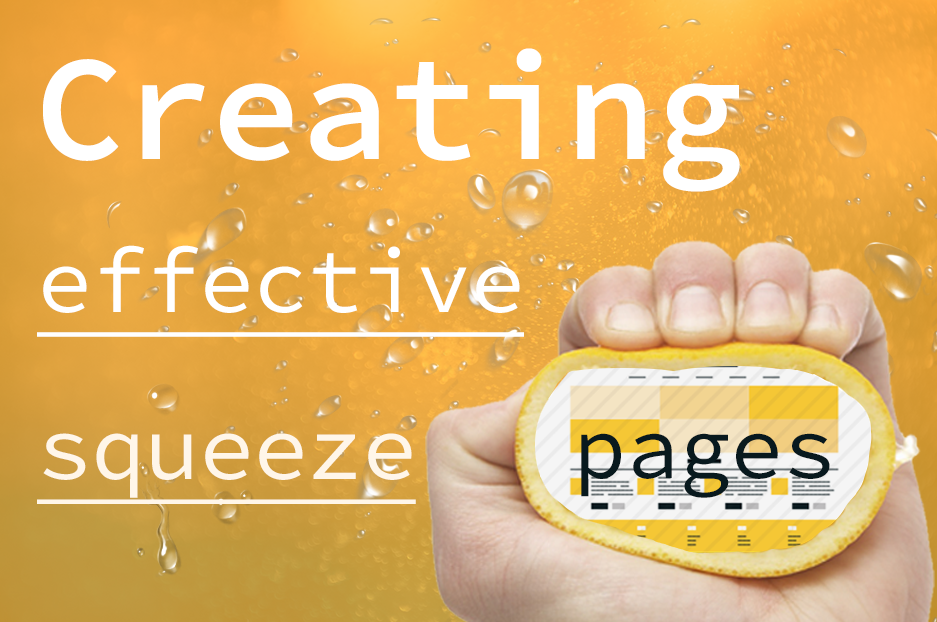“Would you please give me your email address?” is any marketer’s silent question to their target audience. Any marketer understands what a valuable thing a mailing list is. But how does the customer feel about this question, and what could make them say “yes”? Understanding this is very important for building effective squeeze pages.
Squeeze pages: what do they squeeze?
Squeeze pages are a type of landing pages whose primary goal is to make a user submit their email address to the form. The word “squeeze” refers to getting something out of someone that they are reluctant to give. So the expression implies a certain 'pressure,' but a lot depends on how you do that — whether you have sufficient respect and understanding and an appealing information presentation.
Remember that any squeeze page is by default annoying, you are, by default, a spammer for your users, they are always free to leave, and it’s up to you to persuade them to stay. So let’s begin persuading!
Have your squeeze page offer something irresistible
Before your visitors’ fingers eagerly seek the “close” button, try to offer something lucrative and valuable. It should be something that really needs an email address.
Promise to send them a gift certificate, an e-book, a tutorial, a collection of white papers, a new catalog, tips from experts, a promo code, discount offers, a study course, free access to a service or something else you know will be useful. It’s a good idea to divide the information into smaller chunks, this way you will have more “dates” with your loved subscribers.
Always fulfill your threat promise and actually send something to them. You can use an autoresponder for this purpose.
Make the squeeze page more appealing by using:
- colors that are restful to the eyes
- captivating images that inspire positive emotions
- videos (while watching, users will have time for other actions like subscribing)
- a clear and understandable text, structured with bullets if it helps convey the meaning
- a customized call-to-action button with the emphasis on what the user will get (“Yes, please, send me this e-book”)
- social buttons with the count of people who liked/shared/downloaded this (to make this number bigger, promote the page in social media)
- a promise of an easy, 1-click unsubscribe
Minimal form fields: do not ask for too much
It’s always a big temptation to discover more about your audience. But, when you are trying to get them on your mailing list, their email address is the only thing you need to ask for. Often, squeeze pages also ask for a name, which is probably not necessary (the less effort is required from the user, the better). And it seems quite an intrusion to ask for a phone number or, still worse, for a postal address.
You can satisfy your curiosity later. A “thank you” page which follows the subscription stage is a chance for you to include additional questions, but make the answers optional.
Squeeze page types: pop-ups & splash pages
Let’s dwell upon the most popular types of squeeze pages, which are pop-ups and splash pages.
A pop-up squeeze page is probably the most risky, with a higher chance of rejection — it is seen as an obstacle that needs to be removed. If it turns out to be not convincing enough for users to submit their email address, at least they should see a clearly visible “close” button.
A splash page works in a milder way. It’s a welcome page where users are redirected when they come to your homepage. It offers a subscription form just like a pop-up squeeze page, but does not obstruct the view. Be sure to include an obvious “no, thank you, take me to the homepage” button, otherwise puzzled users may never get to your site. Cookies will help avoid showing it to the same users.
You can also use an ordinary landing page as a squeeze page. The “squeezing” will be more “gentle,” but if you offer something valuable and relevant to people’s needs, it may work well. For example, talk about something in an article and then offer to send some good tool or tutorial to help with it.
Freedom and fair play
Just as we agreed at the beginning of this discussion, we should respect and understand our customers. The easy-to-find “close” and “no, thank you” buttons discussed in the previous chapter are an absolute must, because they reduce the annoyance and emphasize the visitors' freedom. With them, chances are higher for just a squeeze page to be closed and not the entire site.
Sometimes, “no” buttons are written like “No, thanks, I do not want more profits”. You may think you’ve outsmarted the user, and they won’t click on such a negative message. No way! They see through these tricks, and are likely to click on it just to get rid of you, feeling annoyed by the way.
In addition, be careful and respectful as to what process you interrupt with your pop-up squeeze page. Would you like appreciate being shown half of the video and be promised the rest by email? We bet you wouldn't!
The main goal is not an email address at all costs, but a happy customer!
Get yourself a squeeze page
You can create a squeeze page with almost any platform or tool that you are using for your site. There also are various squeeze page generators on the World Wide Web.
If you want a beautifully looking and effective customized squeeze page designed for you, our Drupal web design company is ready to help.
Understand your customers, “squeeze” gently, have lots of grateful and positive users on your mailing list, and may they be delighted with what you send them!

